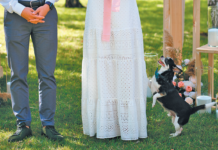You like the generally friendly and easygoing temperament of a golden retriever but prefer the look of a curly-haired pet like a poodle, especially since curly-haired dogs don’t shed as much as those with straight hair. So you find someone who calls themselves a goldendoodle breeder to get the best of both worlds, but his bitch ends up delivering only puppies with straight hair. What gives?
“Very few goldendoodles are more than four or five generations out from a purebred poodle or a purebred golden retriever,” says Tufts veterinary geneticist Jerold Bell, DVM. “And there’s still a lot of cross-breeding going on” from all different lines of dogs, he comments. In other words, it takes many generations of dogs to come up with a standard for a breed profile, and those who are trying to create the perfect goldendoodle are in their earlier stages.
Also, many people are breeding golden retrievers to poodles willy nilly without specific traits in mind. They may not be specifically selecting for curly hair and therefore are getting all kinds of hair textures. They may not be selecting for temperament, either, so you could very well end up with a mix who’s relatively high-strung, like a poodle might be, rather than mellow and great with young children, like a golden retriever tends to be.
Another issue is the size of a dog. Poodles come in three sizes — standard, miniature, and toy. You might get very different-looking dogs depending on the size of the poodles being bred to golden retrievers.
Health issues
Dr. Bell says a lot of people want a dog that is a mix of two breeds in the belief that it will lessen the likelihood of passing down the genes for a disease known to affect one of the breeds disproportionately. Not true. Mixed breed dogs come with just as many genetically inherited diseases as purebreds, he notes. In fact, if you don’t do genetic testing on dogs before having them mate, you could end up with offspring that are predisposed to diseases particular to both breeds. “You don’t just automatically get rid of all the extraneous bad stuff when you mate two dogs of different breeds,” Dr. Bell says.
You can even end up creating health problems where there wouldn’t have been any, he comments. This is “especially so with smaller-stature breeds,” he says. For instance, if you breed a cavalier King Charles spaniel with a miniature poodle to get what people call a cavapoo, or a cavalier with a bichon frise for a so-called cavachon, you could end up with a dog that has “some significant dental malocclusions,” meaning the jaw doesn’t shut properly to bring the upper and lower teeth together. Teeth already tend to be crowded in small dogs, Dr. Bell says. (See story on the dental disease of small dogs on page 5.) This might only exacerbate the problem.
And it’s not just teeth, Dr. Bell points out. “Sometimes other body structures don’t fit well together, either. You can get patella luxation, too,” a potentially painful condition in which a dog’s kneecap is completely or partially dislocated, causing various degrees of lameness. Sometimes a surgery costing $2,000 to $3,000 is required to fix the problem.
The bottom line: most of the time, when you’re dealing with half breeds, you’re not getting the predictability of looks and temperament that you would get with a purebred dog, and you’re not sidestepping the possibility of genetically based diseases, either.
There is, however, one half breed mix that is further along than others. The box below tells the story.
Labradoodles on the Way to Becoming a Breed
While there’s not yet such thing as a goldendoodle or cavapoo breed, “Labradoodles are an interesting story,” says Tufts veterinary geneticist Jerold Bell, DVM. “People are trying to create purebred Labradoodles, and they’ve been doing it since the early 1990s, so we’ve got oodles of generations with these guys.
“The Australian Labradoodle Association of America (ALAA) closed their stud book [no more outside blood will be accepted — the founding stock for creating the breed is set]. And it’s looking to gain recognition with the AKC” (American Kennel Club), he says. That’s the body responsible for accepting new breeds and setting their standards. “This group is at the forefront of making a breed,” Dr. Bell notes.
He notes that when Australian Labradoodle breeders started, they were working primarily with standard poodles, but they are now emphasizing miniature poodles because “more people want smaller dogs today.” In addition, Dr. Bell relates, the ALAA is “very interested in developing the breed as therapy dogs, where a smaller size works really well. They also conduct regular health surveys and have an organized health testing program.”






Great idea to produce smaller labradoodles especially for therapy dogs……. of ourse with their wonderful personalities.
Now if we only could produce healthier Cavalier King Charles Spaniels!!!!
Sorry nothing like a purebred lab. Great with kids, trainable and good temperament. That’s why they are used for the blind, hearing and disable people, they are people dogs. I prefer the English Lab.
Labs are wonderful, wonderful dogs, but the shedding is a problem for a lot of people.